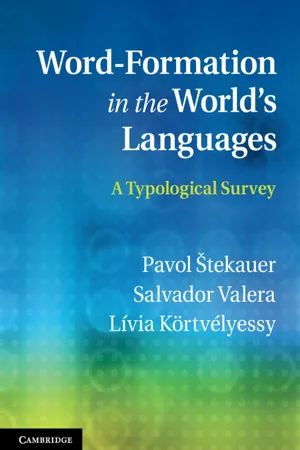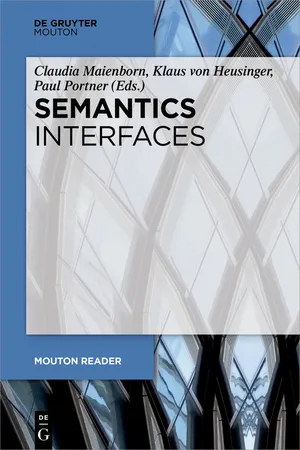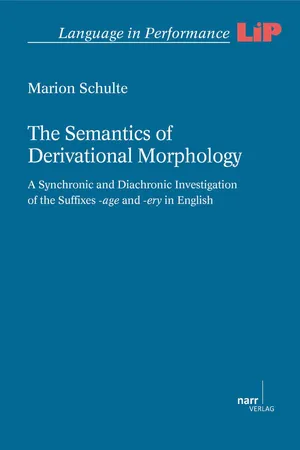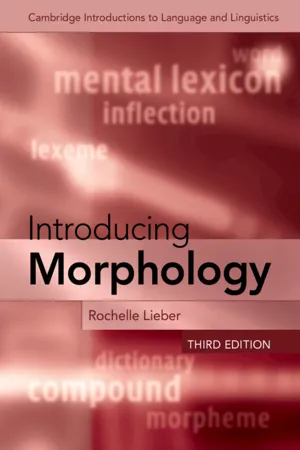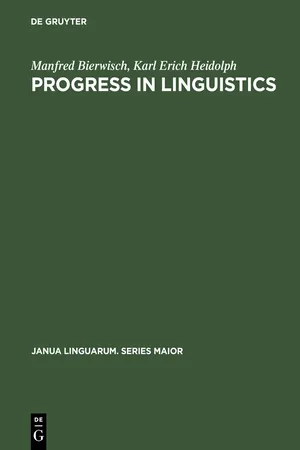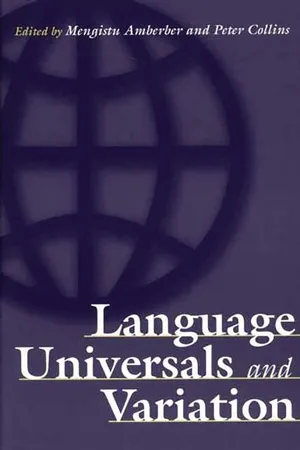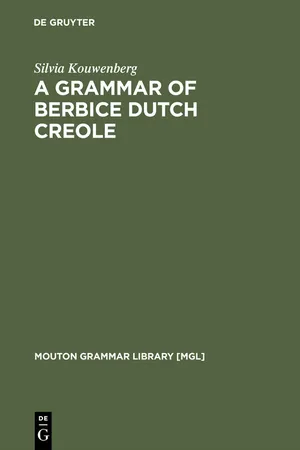Languages & Linguistics
Affixation
Affixation is a process in linguistics where affixes, such as prefixes, suffixes, and infixes, are added to a base or root word to create a new word or modify its meaning or grammatical category. This process is common in many languages and is used to form new words, change verb tense, indicate plurality, and more.
Written by Perlego with AI-assistance
Related key terms
1 of 5
12 Key excerpts on "Affixation"
- No longer available |Learn more
- (Author)
- 2014(Publication Date)
- University Publications(Publisher)
________________________ WORLD TECHNOLOGIES ________________________ Chapter- 3 Affix & its Types Affix An affix is a morpheme that is attached to a word stem to form a new word. Affixes may be derivational, like English -ness and pre-, or inflectional, like English plural -s and past tense -ed . They are bound morphemes by definition; prefixes and suffixes may be separable affixes. Affixation is, thus, the linguistic process speakers use to form new words (neologisms) by adding morphemes (affixes) at the beginning (prefixation), the middle (infixation) or the end (suffixation) of words. Positional categories of affixes Affixes are divided into several categories, depending on their position with reference to the stem. Prefix and suffix are extremely common terms. Infix and circumfix are less so, as they are not important in European languages. The other terms are uncommon. Categories of affixes Affix Example Schema Description Prefix un-do prefix-stem Appears at the front of a stem Suffix/Postfix look-ing stem-suffix Appears at the back of a stem Infix Minne‹flippin'›sota st‹infix›em Appears within a stem — common in Borneo-Philippines languages Circumfix a›scatter‹ed circumfix›stem‹circumfix One portion appears at the front of a stem, and the other at the rear - No longer available |Learn more
- (Author)
- 2014(Publication Date)
- University Publications(Publisher)
________________________ WORLD TECHNOLOGIES ________________________ Chapter- 6 Affix & its Types Affix An affix is a morpheme that is attached to a word stem to form a new word. Affixes may be derivational, like English -ness and pre-, or inflectional, like English plural -s and past tense -ed . They are bound morphemes by definition; prefixes and suffixes may be separable affixes. Affixation is, thus, the linguistic process speakers use to form new words (neologisms) by adding morphemes (affixes) at the beginning (prefixation), the middle (infixation) or the end (suffixation) of words. Positional categories of affixes Affixes are divided into several categories, depending on their position with reference to the stem. Prefix and suffix are extremely common terms. Infix and circumfix are less so, as they are not important in European languages. The other terms are uncommon. Categories of affixes Affix Example Schema Description Prefix un-do prefix-stem Appears at the front of a stem Suffix/Postfix look-ing stem-suffix Appears at the back of a stem Infix Minne‹flippin'›sota st‹infix›em Appears within a stem — common in Borneo-Philippines languages Circumfix a›scatter‹ed circumfix›stem‹circumfix One portion appears at the front of a stem, and the other at the rear - eBook - PDF
Word-Formation in the World's Languages
A Typological Survey
- Pavol Štekauer, Salvador Valera, Lívia Kőrtvélyessy(Authors)
- 2012(Publication Date)
- Cambridge University Press(Publisher)
This chapter discusses the status of affixes (4.1) and reviews the role of suffixation and prefixation (4.1.1), with emphasis on recursiveness (4.1.1.1) and base modification (4.1.1.2) and then on one-to-many (4.1.2) and many- to-one relations (4.1.3) within Affixation. The chapter then presents minor types of Affixation (4.2), notably infixation (4.2.1), prefixal-suffixal derivation (4.2.2), circumfixation (4.2.3), and prefixal-infixal and infixal-suffixal deriva- tion (4.2.4). 4.1 Affixation Morphology sometimes alludes to affixes as well-defined elements that in fact may vary considerably. A number of examples illustrate the difficulty in defining the boundaries of derivational affixes with respect to inflectional affixes or to other structural units. Thus, Malkiel (1978) refers to German elements, most of which are formally and semantically paralleled by prepositions and/or adverbs (cf. Table 2.1). This might suggest that words containing these elements are compounds. However, the existence of prefixes without any corresponding lexical coun- terparts like be-, er-, ge- and ver- suggests that these words result from Affixation. Malkiel (1978: 127–8) argues that it would be counterintuitive to separate be-, er-, ge- and ver- from the remainder of German prefixes with which they interact paradigmatically. A similar situation characterizes the majority of Latin verbal prefixes. In fact, as pointed out by Kastovsky (2009: 327), affixes often go back to compound members due to loss of their content. Thus, English -less goes back to Old English less meaning ‘devoid of, free from’, -ship to Old English 136 word-formation processes with bound morphemes scipe ‘form, state’ and -dom to Old English dōm ‘evil fate’. Synchronically, this source may be traced in the existence of the so-called semiaffixes (English -berry, -man, etc., cf. Marchand 1960: 290ff.). - eBook - PDF
- Ingo Plag, Maria Braun, Sabine Lappe, Mareile Schramm(Authors)
- 2011(Publication Date)
- De Gruyter Mouton(Publisher)
We have also seen in the pre-vious section that one such way is adding derivational affixes to existing bases. However, there are many other ways by which speakers can create new lexemes and thus give names to new things, abstract notions, etc. (33) inflectional affixes derivational affixes – are always suffixes in English – can be suffixes and prefixes – have consistently the same gram-matical function in every word they attach to – can have different meanings in different words – attach to every word of a given class – attach to certain words of a given class – never change the word-class of the base – can change the word-class of the base Word-formation 89 If, for example, a five-year-old child whose native language is English wants to invent a name for a flag decorated with moons, he or she might nat-urally call this type of flag a moon-flag because as a speaker of English the child knows that new concepts can be denoted just by putting several words together into one (example from Clark 1993: 148). Or imagine a situation in which a speaker is faced with the necessity to tell her interlocutor that she searched the internet auction ebay the day before. The strategy this speaker would possibly resort to is just using the name ebay to denote the process as-sociated with this name: I have been ebaying yesterday till late in the evening . The speaker would do so probably because she is aware of the fact that one and the same form can be used to denote both objects and processes con-nected with these objects. Yet another situation would trigger the use of a dif-ferent strategy. For instance, if the speaker is an experienced university stu-dent who has attended many lectures, she might refer to a lecture as lec in a conversation with her fellow-students one day. - eBook - PDF
- Claudia Maienborn, Klaus Heusinger, Paul Portner, Claudia Maienborn, Klaus Heusinger, Paul Portner(Authors)
- 2019(Publication Date)
- De Gruyter Mouton(Publisher)
3 Semantics of derivational morphology 77 1999: 50). Further, such lexical affixes are often lexicalized in specific forms. Finally, in discourse such affixes often serve to designate old information. On first mention, an independent noun root will be used, but in subsequent mentions the suffix can be used to background the already mentioned item. Mithun argues further that although lexical affixes might have developed historically from com-pounding forms, the above factors suggest that they are no longer compounding forms, but constitute bona fide affixes. It should be noted that even Indo-European languages occasionally have affixes that seem to have robust lexical content. For example, French has an affix -ier that attaches to roots denoting types of fruit to derive the corresponding type of fruit tree: poire ‘pear’ ~ poirier ‘pear tree’. The conclusion we are forced to is that lexical affixes indeed present a chal-lenge to the notion that derivation covers a rather abstract, fixed set of categories. We will see that this issue arises again in connection with the theoretical treat-ment of derivational semantics in section 3. 1.3 Difficulties in distinguishing derivation from inflection Just as it is difficult in some cases to delimit the semantics of derivation with respect to compounding of bound roots, it is also sometimes difficult to cir-cumscribe those semantic categories that belong to derivation from those that belong to inflection (cf. also article 2 [this volume] (Kiparsky & Tonhauser) Seman-tics of inflection ). The distinction between inflection and derivation is frequently made on the basis of formal criteria: inflection, according to Anderson (1982) is what is relevant to the syntax. In other words, markings that induce or participate in syntactic dependencies such as agreement are said to be inflectional. Similarly, distinctions that are reflected paradigmatically are often said to be inflectional. - eBook - PDF
The Semantics of Derivational Morphology
A Synchronic and Diachronic Investigation of the Suffixes -age and -ery in English
- Marion Schulte(Author)
- 2015(Publication Date)
- Narr Francke Attempto Verlag(Publisher)
This is a strong claim, and there is evidence to suggest that it is indeed too strong a claim. Mithun has shown that affixes in Bella Coola, a Salishan language spoken in Canada, “show characteristics that are considerably more root-like than most affixes“ (1997: 369). She therefore calls these affixes lexical affixes . It is certainly correct, however, that most affixes usually ex-press limited meanings, and thus differ from lexemes, as the meanings that may be expressed by lexemes are potentially infinite. However, this seems to be a difference of degree rather than a difference in kind. Lehrer claims that “[i]n looking at all the cases we see a cline rather than a clear-cut division” (2000: 152). Such an approach would allow some affixes to have a very lim-ited meaning, which is restricted to grammatical functions, while other af-fixes could express more lexical meanings. It is generally assumed that Eng-lish derivational affixes have rather restricted grammatical meanings, but the results of this study suggest that at least some English affixes, i.e. the suffix -age , which often refers to charges and taxes in Middle English coinag-es, also have more lexical meanings in addition to grammatical ones. It thus seems better to assume a cline from more grammatical to more lexical mean-ing in affixes rather than a clear-cut division between affix and lexeme meanings. Synonymy between different affixes is another point that is often made to argue that affixes should not be considered linguistic signs, i.e. a unit of form and meaning (Beard 1995, Beard & Volpe 2005, Raffelsiefen 2010). In-deed, a number of different affixes derive complex words with similar func-tions. Action nouns, for example, are attested with all of the following suf-fixes, but may also be derived by conversion: -ing , -age , -ment , -ure , -th , -ation , and -al . The same is true for collective nouns, which may contain, among others, the suffixes -age , -ery , -ship , -hood , or -dom . - eBook - PDF
- Rochelle Lieber(Author)
- 2021(Publication Date)
- Cambridge University Press(Publisher)
Once we know this, we N A A un happy ness V V A re pure ify FIGURE 3.2 Words are like onions to do it the other way around, -ness would have first created a noun, and then un- would be unable to attach. We could represent the order of attachment as if words really were onions, with the base in the inner- most layer, and each affix in its own succeeding layer: see Figure 3.2. 3.3 Affixation 43 3.3.3 What Do Affixes Mean? When we made the distinction between affixes and bound bases above, we did so on the basis of a rather vague notion of semantic robustness; bound bases in some sense had more semantic meat to them than affixes did. Let us now attempt to make that idea a bit more precise by looking at typical meanings of affixes. In some cases, affixes seem to have not much meaning at all. Consider the suffixes in (14): (14) Beyond turning verbs into nouns with meanings like ‘process of X-ing’ or ‘result of X-ing’, where X is the meaning of the verb, it’s not clear that the suffixes -(a)tion, -ment, and -al add much of any meaning at all. Similarly with -ity and -ness, these don’t carry much semantic weight of their own, aside from what comes with turning adjectives into nouns that mean something like ‘the abstract quality of X’, where X is the base adjective. Affixes like these are sometimes called transpositional affixes, meaning that their primary function is to change the category of their base without adding any extra meaning. Contrast these, however, with affixes like those in (15): (15) These affixes seem to have more semantic meat on their bones, so to speak: -ee on a verb indicates a person who undergoes an action; -less means something like ‘without’; and re- means something like ‘again’. a. -(a)tion examination, taxation, realization, construction -ment agreement, placement, advancement, postponement -al refusal, arousal, disposal b. -ity purity, density, diversity, complexity -ness happiness, thickness, rudeness, sadness a. - eBook - PDF
- Martin Everaert, Mieke Trommelen, Riny Huybregt, Martin Everaert, Mieke Trommelen, Riny Huybregt(Authors)
- 2019(Publication Date)
- De Gruyter Mouton(Publisher)
Affixations, I propose, are either syntactic or lexical. Examples of lexical Affixations are English destruct-ion, happy-ness, manoeuver-able. Lexically built words like these may or may not be represented in the lexicon as in (1); the evidence for hierarchical structure in lexical items is, however, weak in English. That is, evidence that affixes are asymmetrical with respect to each other is minimal; only prefix-suffix pairs would be capable of showing an asymmetry, but the phonological rules do not provide evidence of asymmetry and the only evidence comes from selectional restrictions: some prefixes seem to be sensitive to the presence of the outermost suffix (or vice-versa) in the word to which they attach. My claim that there are syntactic representations of the type in (1) goes against a strong version of the Lexicalist Hypothesis, which claims that syntactic rules do not have access to the internal structure of words. The strong Lexicalist Hypothesis says in effect that the syntax is 'the place where sentences are made', and the lexicon is 'the place where words are made'. This strong Lexicalist Hypothesis is not a necessary consequence of the 'rules and representations' approach of Government-Binding Theory, where a syntactic representation is more or less any object which can be constructed so that it conforms to syntactic constraints. For Government-Binding Theory, every structure is allowed unless it is ruled out; there is no logical necessity to have as part of the theory a constraint which says that structures like (1) are ruled out in the syntax (though such a constraint, in effect the Strong Lexicalist Hypothesis, might be part of the syntactic theory). In this paper I argue that there are gains for GB Theory in terms of the generalisation of Case Theory which suggest that such a 'Strong Lexicalist' constraint is in fact not part of the theory. - eBook - PDF
- Manfred Bierwisch, Karl Erich Heidolph(Authors)
- 2014(Publication Date)
- De Gruyter Mouton(Publisher)
PAUL G. CHAPIN ON Affixation IN ENGLISH* Among the regularities of language which interest linguists are the relationships be-tween words and their derivatives. These relationships are generally referred to col-lectively as the derivational morphology of a language. This paper is an investigation into a part of the derivational morphology of English from the point of view of a generative grammar, i .e., a set of explicit rules which characterize a language fully and precisely. The rules governing the formation of derivatives from stems lie at the crossroads of a grammar. Both morphological and syntactic information are often relevant in determining the applicability of a rule. The complexity of interaction between mor-phology and syntax is such that a theory of language which postulates a grammar divided sharply into a generative syntax and an interpretive phonology 1 encounters serious difficulties at this point. A decision to place rules of derivation in either the syntactic or the phonological component, in this theory, leads to the undesirable result that some generalizations will be unstatable. Various somewhat speculative proposals have been made as to ways to alleviate the situation. They include the postulation of a 'derivational component' and a greatly enriched theory of the structure of the lexicon. The proper characterization must of course be determined empirically, by examining the facts of derivation as they relate to other known facts about language. The focus of this paper will be on one factual area, the ordering of some derivational rules of English. A great deal of evidence has been accumulated, independently of any ques-tions of derivation, as to the ordering of the phonological and syntactic rules of English. 2 Thus if the facts of derivation ordering are known, a test is available as to the compatibility of the derivational rules with the other rule systems. - eBook - PDF
- Mengistu Amberber, Peter Collins, Mengistu Amberber, Peter Collins(Authors)
- 2002(Publication Date)
- Praeger(Publisher)
The diachronic account of the differential behavior of verbal suffixes and verbal prefixes is intended to provide a basis for the empirical fact that there is motivation to the verbal organization Affixes, Clitics, and Bantu Morphosyntax 193 Figure 8-1. given previously, at least in its identification of the VS as a significant subdomain. The proposal made here is that the prefixal material is not affixal in a sense comparable to that applicable to verbal extensions. Rather, the prefixal elements are clitics, categorically non-verbal, and more involved in the morphosyntactic organization as opposed to the morpholexical aspects characterizing the extensions. AFFIXES V E R S U S CLITICS Affixes are bound morphemes, constituents of words that occur at- tached to some host that may itself be free or bound. Haverkort notes that "affixes exhibit a high degree of selection with respect to their stems" (Haverkort, 1993:115). Clitics, on the other hand, while syntacti- cally independent, are phonologically bound. They appear " prosodically bound to an adjacent word" (Halpern, 1998:104). Further, they exhibit a low degree of selection with respect to their hosts. The property of being bound that characterizes affixes is relevant to the study of pre-verb stem elements and verbal suffixes (extensions) in Chichewa. The exten- sions only select verb roots, are morphologically bound, and, at the level of phonology, do not satisfy the basic syllable structure or phonotactics of the language. The causative, applicative, passive, stative, and recipro- 194 Language Universals and Variation cal extensions in Chichewa are (ignoring variants determined by vowel harmony), respectively, -its-, -il-, -idiu-, -ik-, and -an-. Notably, all these have a phonological structure of-VC-, departing from the basic syllable struc- ture of the language. In a study of syllable structure of Chichewa, Mtenje argued that "Chichewa syllables are essentially of a CV nature" (1980:2). - eBook - PDF
- Silvia Kouwenberg(Author)
- 2011(Publication Date)
- De Gruyter Mouton(Publisher)
8. Morphology Traditionally, two sets of Word Formation Rules, i.e. rules of combining morphemes into words, are distinguished: Affixational (derivational and inflectional) and compounding. This chapter is divided along these lines. In addition, category conversion is discussed separately. Affixational morphology will be considered in 8.1 (including a discussion of a possible clitic status of -je), category conversion in 8.2, compounding in 8.3. 8.1. Affixational morphology Creole languages are commonly noted for their lack of Affixational morphology, both derivational and inflectional. Both reduplication and category conversion (also known as zero-derivation and as multifunctionality) have been looked upon as Creole strategies for dealing with a lack of inflectional morphemes, in the face of the need to expand the lexicon (Voorhoeve 1980), or, in the case of reduplication, to increase its stylistic flexibility (Mühlhäusler 1986). Neither of these strategies requires the existence or development of separate, phonetically specified grammatical morphemes. BD conforms to this pattern: it has very little Affixational morphology. Bound morphemes in BD are aspect suffixes, the nominalizer (but see the discussion below on a possible clitic status of the nominalizer), and the plural suffix. Affixation is always suffixation in BD. In the following, reduplication will be treated as a special case of suffixation, one that involves the suffixation of a morpheme identical to the base. The suffixational rules which may thus be distinguished in BD are listed in Table 8.1. Note that verbal inflection is discussed in 3.1.1 (on Tense, Mood, Aspect) and will not be examined here with the exception of iterative reduplication. For a discussion of pronominal inflection one is referred to 6.3 (the distribution of pronouns). In some cases, a derived form may form the input of another rule; this will be mentioned below where relevant. - eBook - PDF
Linguistics for Everyone
An Introduction
- Kristin Denham, Anne Lobeck(Authors)
- 2012(Publication Date)
- Cengage Learning EMEA(Publisher)
We certainly recognize warm , berry , in -, and un - as regularly occurring morphemes in English because they occur in many other words ( rewarm/warming, huckleberry/strawberry/blueberry, inoper-able/incredible/invincible, unthinkable/unhappy/unsafe ). The morphemes luke -, cran -, -ept , and -kempt , on the other hand, appear only in lukewarm , cranberry , inept , and unkempt . We don’t use the term lukecold , nor do we use cran-anywhere other than attached to berry , and we don’t ever say “He is an inept writer, but she is very ept” or “Her hair looked kempt”. So the rules that attach un-to -kempt or luke-to warm are not produc-tive; they derive only these words. We will also define mor-phemes such as cran-, luke-, -ept , and -kempt as bound roots because they cannot stand alone as free morphemes and because they don’t occur as affixes in other English words. So, to summarize this section, morphemes can be bound or free, and they can be roots or affixes. Roots can be free mor-phemes or bound ones, but affixes are always, by definition, bound morphemes. Affixes can attach to words in various ways, as prefixes, suffixes, circumfixes, and infixes. In the following section, we turn our attention to Affixation in more detail, discussing another way in which we can distinguish affixes: by dividing them into two different types, with differ-ent properties— derivational affixes and inflectional affixes. Derivational Affixation Most of the examples of affixes in English that we have discussed so far have been of derivational affixes , affixes that attach to other morphemes to form new words that are separate entries in our mental dictionary, or lexicon. The affix -able attaches to verbs, deriving adjectives. The affix -able is therefore a derivational affix—an affix that derives a new word, a new dictionary entry.
Index pages curate the most relevant extracts from our library of academic textbooks. They’ve been created using an in-house natural language model (NLM), each adding context and meaning to key research topics.


